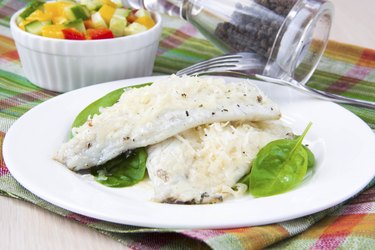
Whitefish refers to round- or flat-shaped fish with fins that live near or on the bottom of sea or lakes that are white in color. This includes cod, haddock, halibut, haddock, whiting, bass, hake, flounder, cat fish, pollock, perch and whiting. Whitefish are among the most common types of fish resulting in an allergic reaction. Seek immediate medical attention if you develop breathing difficulties as you may have a life-threatening reaction.
Immune Response to Whitefish
Video of the Day
According to Food Allergy Research and Education, cod, tilapia, haddock, hake, pollock and catfish are the most common kinds of whitefish that trigger an allergic reaction. An allergic reaction to whitefish occurs via an immunoglobulin E-mediated immune response. The immune system recognizes paravulbumin, a muscle protein conserved in all species of fish, as foreign and dangerous. The immune system starts producing IgE antibodies that target and destroy these proteins. They also recruit and bind to proinflammatory immune cells, primarily mast cells, and cause the release of histamine and other immune mediators, resulting in the signs and symptoms observed during an allergic reaction.
Video of the Day
Symptoms of an Allergic Reaction to Whitefish
The symptoms of an allergic reaction to whitefish appear within a few minutes to an hour after contact with the allergens. Itching, swelling and redness of the mouth, throat, lips and face are among the first observed symptoms followed by swelling and reddening of the skin as well as the appearance of itchy hives involved with a skin rash, typically eczema. The release of histamine into the gastrointestinal tract results in abdominal pain, nausea, vomiting and diarrhea. Swelling of the throat and airways can result in bronchospasms, increased resistance to airflow, wheezing, tightening of the chest and difficulty breathing. In severe cases, an allergic person can go into anaphylactic shock, symptoms of which include extreme nausea, dizziness, light-headedness, heart palpitations, low blood pressure and low consciousness, according to Auckland Allergy Clinic. Seek immediate medical attention if you experience breathing difficulties or observe the signs of anaphylaxis.
Management of Whitefish Allergy
The only to avoid an allergic reaction is complete avoidance of whitefish and fish-derived foods. Always read the label and ingredient list of all foods to ensure it does not contain whitefish in any form. Avoid seafood and Asian restaurants as cross-contamination of food readily occurs. Food Allergy Research and Education suggests you avoid Worcestershire sauce, Caesar Salad dressing, caponata, gumbo, paella, sushi, fish sauce, oyster sauce and frito misto as they may contain hidden allergens. If you have experienced a severe allergic reaction in the past, speak with your physician about carrying an epinephrin autoinjector.
Whitefish Nutrition
Whitefish are the leanest types of fish, and unlike oily fish, these varieties of fish only have oil in their liver. They are virtually fat free. Whitefish contain high levels of omega-3 fatty acids, which promote cardiovascular health and reduce your risk of diabetes, cancer and heart disease. Whitefish are also rich in B vitamins including niacin and pyridoxine. They also contain high levels of minerals including iodine, iron, selenium and phosphorous. Iodine and selenium play an essential in maintaining immune system health, thyroid function and preventing infection.
Is this an emergency? If you are experiencing serious medical symptoms, please see the National Library of Medicine’s list of signs you need emergency medical attention or call 911.